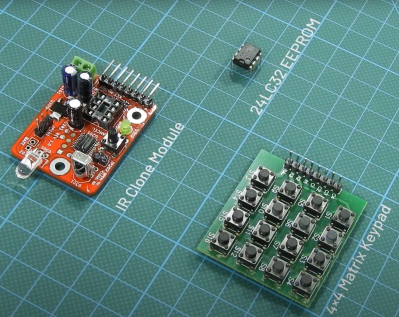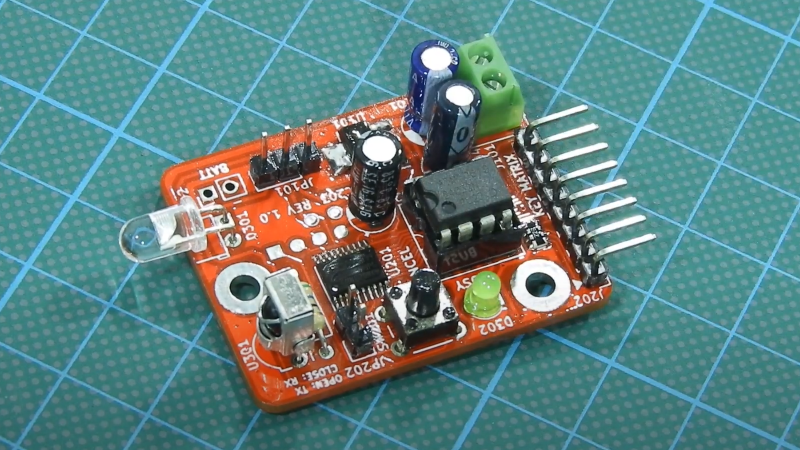Many devices use infrared (IR) as a signalling medium like, for example, RGB LED strip controllers
modules and some TV controllers. Often times these signals aren’t meant for secure applications which means the functionality can be reproduced by simply replaying back the received signal verbatim. Sometimes, enterprising hackers want to reverse engineer the IR signals, perhaps to automate some tasks or just to get a better understanding of the electronics we use in our everyday life. To help in this effort, [dilshan] creates an open source hardware IR cloner device, capable of snooping IR signals and retransmitting them.
The IR cloner is a sweet little IR tool that can be used to investigate all sorts of IR signals.
In addition to the source code and design files, [dilshan] has also taken care to create detailed documentation as an addendum to the video on assembly and usage.

The IR cloner itself is a board that’s just over 41mm by 31mm with mixed surface mount and through hole components. The device has an LD271 IR LED that can transmit in the 880nm to 950nm range with a TSOP181 IR receiver that can receive in the same range. The STM8S003F3 microcontroller sits at the heart of the device. Depending on jumpers, wiring and battery connections, the device can take an external battery pack ranging from 3V or 5V to 9V. The board has an eight pin DIP that is meant to seat a 24LC32 32kbit EEPROM. Header pins are available to attach to an 4×4 pushbutton matrix that is meant to control the unit.
The main workflow looks to be setting the functional mode with the 4×4 pushbutton matrix with the EEPROM acting as storage. The signals can be replayed directly after receipt or can be analyzed more in depth by removing the EEPROM and downloading the saved signal data. [dilshan] recommends using something like an CH341A based programmer to read stored values from the EEPROM.
Having the IR cloner around would be the perfect tool to not only help reverse engineer something like a PixMob wearable LED wristband or an IKEA LED lamp but to use and hack on them yourself.
















It is, although I have an IR blaster that plugs into USB, for back in the day when everything communicated with IR (HP and their portable printer). I imagine it’s all been supplanted by Bluetooth.
I have an old (20 year) commercial “universal remote controller”, that could “learn” the codes of others. You can then chain different codes/functions for different devices together.
Sadly, it’s rubber buttons turned to dust!
Nothing’s new in Tech…
I had one too, about 15 years ago. It was a Logitech brand unit but I don’t recall the name. After learning the codes from your other remotes you could upload them to their public knowledgebase site for others, or download them.
A harmony like remote is (trying) to make a comeback. https://flirc.tv/products/skip1s-remote
That was it, the Logitech Harmony. Thanks!
Cool! I do wonder why he decided on the external EEPROM when the chip has 128B integrated.
Specifically so that the data could be removed, read, manipulated with an unrevealed program, and returned to the device.
This could be done with https://www.sparkfun.com/products/15031
That’s not a 555!
Recomment MCU of the sparkfun IR blaster seems to be an ESP8266.
I have an IR blaster on my phone and Anymote Smart Remote was the perfect app for controlling most IR enabled devices, great for annoying people in the pub by turning the football off and changing the AC settings, having control over every one of your friends TVs, etc – not so much hacking but was entertaining! That was until they ran out of money and shut their servers down, now it’s impossible to add any new remotes. If only the had dumped their entire repository to the app! Now that I am forced to “make do” with devices like this I’ll probably build one just for personal satisfaction :)
Did the same thing with the Logitech Harmony Remote/Hub… They stopped selling the remotes & hub, I still use it because they said they will still support it because enough people use it. I use it on my home theater.
I did the exact same thing and it’s wonderful and empowering. Yes I had all my friends every pub I went to and also potential TVs that I might come across.
Yes I loved it anymore as well I got very well versed with it. It’s a shame they shut down. And yes it’s a shame they didn’t leave it in such a way that the information could still be utilized. But I did run across the website that I don’t know the name of it was probably something like every remote code in the world.com it was something obscure like that I believe and yeah it was maintained by several people and the public. I’ll probably a huge amount of codes from it but I haven’t been back to it in over a decade and I don’t remember the name of the site. I should have checked before making his comment. I’ll start looking and to find it.
I absolutely loved reading your comment. It was almost like I wrote it myself. I’m always looking for a new and creative ways of tormenting people.
Take care my brother.
Me again. Initially I used my phone that had a IR port and I bought Anymote (which was an awesome freaking app). I programmed it to bring all of their equipment back to ground zero. Cuz they were forever getting everything all out of whack. Pushed one button it would bring all the components back to wherever I wanted them and all would be well. I was a freaking hero to all of the elders. Now my name will never be stricken from the protected scrolls.
I made one with an ESP8266… when I used to have a TV…..
The first seven minutes or so of the video is just soldering, then there’s a small demo of it in ‘learning remote’ mode. Then some unexplained activity with a Signal Synthesizer app. Needs quieter music and either commentary or on-screen captions explaining what’s going on.
Anyone remember the JP1 universal remotes and that whole hacking scene? Would have been around 20 years ago when I encountered it. Super fun and extremely useful. Used that setup for years.
Yes! I made my own serial to jp1 adapter, then never got around to actually programming the darn remote. Still on the to do list… But harmony is working well enough for now
Made something simular with ESPHome and an 8266 and 2 IR LEDs. Prints the IR codes out in the terminal for you. Used it to turn on and off my old TV when my phone leaves it’s home zone.
Interesting, might need this to cobble a sat receiver into a PVR lashup.
I’ve been populating the house with Raspberry Pi based IR transcievers, to take control of my HVAC system (which I’m not yet ready to void the warranty on). Lots and lots of solutions out there…
Not bad! In the mid-2000s, I had an old (at the time) Palm Handspring Visor device with an IR transceiver. I found an app for that did exactly this. It was mainly designed to mimic TV remote controls, and it had a lot of built in profiles for common brands, but it also had a function for creating new profiles that could record an incoming signal to be replayed later. Despite being fairly old at the time (around 6 years old, but technologically much more primitive), that thing was extremely useful. It had a decent calculator capable of financial math and with programming math display functions (like displaying values in hex and binary). I installed a Basic interpreter and programmed it to do graphing and advanced math. It was decent for basic note taking, and I used it’s address book functionality for a while too. But that IR functionality and TV remote app made it even more useful as a universal remote. (I still have it somewhere, the screen is too screwed up for it to be useful anymore.)
Anyhow, this is pretty cool! It’s surprising how useful functionality like this can be.